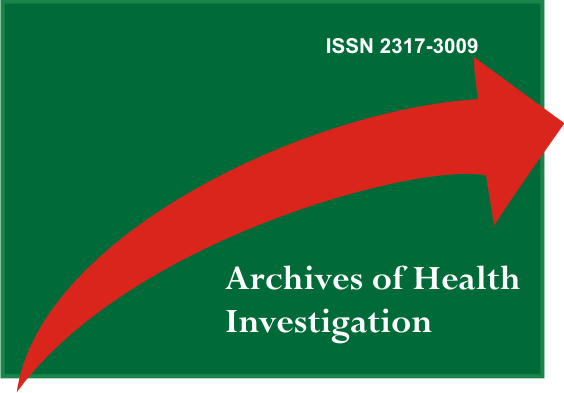Is self-perceived oral health status related to non-carious cervical lesions in Brazilian working adults?
DOI:
https://doi.org/10.21270/archi.v7i9.3131Resumen
This study evaluates the association of Non Carious Cervical Lesions (NCCLs), Oral Health-Related Quality of Life (OHRQoL) and Work Ability Index (WAI) in a Brazilian population of Workers. One hundred workers were evaluated in a CEREST (Worker´s Health Reference Center). Participants were examined for oral disease following WHO recommendations, and the Oral Health Impact Profile (OHIP) and Work Ability Index assessment was used to determine OHRQoL and capacity to work, respectively. Assessment of tobacco use and alcohol consumption was made by Fagestron tolerance and Audit test. Statistical analyses were performed using STATA version 13.0. Dimensions with highest OHIP scores were physical pain and psychological discomfort. In bivariate analyses, NCCLs was significant associated with OHIP-14 severity PR 3.8 (CI95%1.26-11.89) and with self-related of oral pain PR 2.16 (CI95% 1.06-4.40). In the multivariate logistic regression analyses, years of smoking habits OR 1.73 (CI95% 1.03-2.9) was significant associated with OHIP-14 severity, independent of other variables. OHIP14 was significant associated to WAI (p=0,02). Strategies for Monitoring oral health Brazilian workers and reduce tobacco use should be done by Brazilian Companies to support Work ability. For future investigations on OHRQoL, analyses of NCCLs should be included.Descriptors: Quality of Life; Oral Health; Occupational Dentistry; Occupational Health; Tooth Erosion.
Descargas
Citas
Tsakos G, Allen PF, Steele JG, Locker D. Interpreting oral health-related quality of life data. Community Dent Oral Epidemiol. 2012; 40(3):193-200.
Batista M, Lawrence H, de Sousa M. Impact of tooth loss related to number and position on oral health quality of life among adults. Health Qual Life Outcomes. 2014; 12:165.
Batista MJ, Perianes LB, Hilgert JB, Hugo FN, Sousa Mda L. The impacts of oral health on quality of life in working adults. Braz Oral Res. 2014; 28. pii: S1806-83242014000100249.
Gerritsen AE, Allen PF, Witter DJ, Bronkhorst EM, Creugers NH. Tooth loss and oral health-related quality of life: a systematic review and meta-analysis. Health Qual Life Outcomes. 2010; 8:126.
Aw T, Lepe X, Johnson G, Mancl L. Characteristics of noncarious cervical lesions - A clinical investigation. J Am Dent Assoc. 2002; 133(6):725-33.
Lussi A, Jaeggi T. Erosion - diagnosis and risk factors. Clin Oral Investig. 2008; 12(Suppl 1):S5-13.
Wiegand A, Burkhard J, Eggmann F, Attin T. Brushing force of manual and sonic toothbrushes affects dental hard tissue abrasion. Clin Oral Investig. 2013; 17(3):815-22.
Scaramucci T, de Almeida Anfe TE, da Silva Ferreira S, Frias AC, Sobral MA. Investigation of the prevalence, clinical features, and risk factors of dentin hypersensitivity in a selected Brazilian population. Clin Oral Investig. 2014; 18(2):651-57.
Slade GD, Nuttall N, Sanders AE, Steele JG, Allen PF, Lahti S. Impacts of oral disorders in the United Kingdom and Australia. Br Dent J. 2005; 198(8):489-93.
Brennan DS, Teusner DN. Oral health impacts on self-rated general and oral health in a cross-sectional study of working age adults. Community Dent Oral Epidemiol. 2015; 43(3); 282-88.
Monteiro MS, Ilmarinen J, Correa Filho HR. Work ability of workers in different age groups in a public health institution in Brazil. Int J Occup Saf Ergon. 2006; 12(4):417-27.
Bomfim RA, Crosato EM, Mazzilli LEN. Relations between oral health and work ability among administrative workers. Braz J Oral Sci. 2015; 14(1):41-5.
Roncalli AG, Silva NN, Nascimento AC, Freitas CHSM, Casotti E, Peres KG et al. Aspectos metodológicos do Projeto SBBrasil 2010 de interesse para inquéritos nacionais de saúde. Cad Saude Publica. 2012; 28(Sup):S40-57
Bomfim RA, Crosato E, Mazzilli LE, Frias AC. Prevalence and risk factors of non-carious cervical lesions related to occupational exposure to acid mists. Braz Oral Res. 2015; 29(1):1-8.
Gelbier S. Book Reviews. Oral health surveys - basic methods. World Health Organization. Int J Epidemiol. 1977; 6(4):405-6.
Oliveira BH, Nadanovsky P. Psychometric properties of the Brazilian version of the Oral Health Impact Profile-short form. Community Dent Oral Epidemiol. 2005; 33(4):307-14.
Petersen PE, Kwan S. The 7th WHO Global Conference on Health Promotion - towards integration of oral health (Nairobi, Kenya 2009). CDH. 2010; 27(Suppl 1):129-36.
Campos Guerra MJ, Greco RM, Goncalves Leite IC, Ferreira e Ferreira E, Queiroz de Paula MV. Impact of oral health conditions on the quality of life of workers. Cienc Saude Colet. 2014; 19(12):4777-86.
Lacerda JT, Ribeiro JD, Ribeiro DM, Traebert J. Prevalence of orofacial pain and its impact on the oral health-related quality of life of textile industries workers of Laguna, SC, Brazil. Cienc Saude Colet. 2011; 16(10):4275-82.
Lacerda JT, Traebert J, Zambenedetti ML. Orofacial pain and absenteeism in workers of the metallurgic and mechanics industry. Saude Soc. 2008; 17(4):182-91.
Ramseier CA, Warnakulasuriya S, Needleman IG, Gallagher JE, Lahtinen A, Ainamo A et al. Consensus Report: 2(nd) European workshop on tobacco use prevention and cessation for oral health professionals. Int Dent J. 2010; 60(1):3-6.
Batchelor P, Sheiham A. The limitations of a 'high-risk' approach for the prevention of dental caries. Community Dent Oral Epidemiol. 2002; 30(4):302-12.


